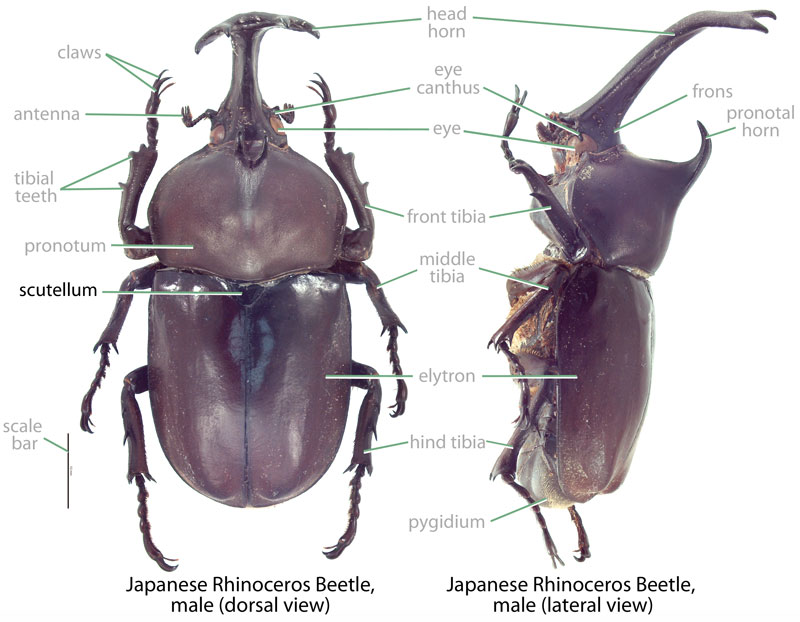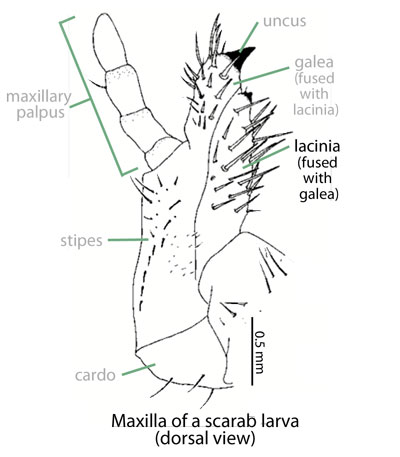Beneficial
Oklahoma dung beetle
Family: Scarabaeidae Subfamily: Scarabaeinae Genus: Onthophagus Species: Onthophagus oklahomensis Brown, 1927
none available
Total body length 2.0–4.1 mm (0.07–0.16 in). Body shape oval; may be caked in dung. Color shiny black. Size tiny, under 6 mm. Clypealclypeal:
of, or referring to, the clypeus
apexapex:
point or edge furthest from the body
rounded, never emarginateemarginate:
notched or with a rounded section removed from the margin, often applied to the anterior margin of the clypeus
; female with frontoclypeal suturefrontoclypeal suture:
transverse suture between the clypeus and frons
very feeble, male suture indistinct. Head without horns or tubercles. Ocular canthuscanthus:
a process extending over and sometimes dividing the eye
not completely dividing eye. Scutellumscutellum:
the triangular portion of the thorax between the bases of the elytra
 absent.
absent.
Undescribed. For Onthophagus spp. (Ritcher, 1966Ritcher, 1966:
Ritcher P. 1966. White grubs and their allies: a study of North American scarabaeoid larvae. Oregon State University Monographs, Studies in Entomology 4: 1-219.): Grub C-shaped, hump-backed, cylindrical, and cream-colored. Maxillamaxilla:
set of paired mouthparts located posterior to the mandibles
with galeagalea:
outer branch or lobe of the maxilla
 and lacinialacinia:
and lacinialacinia:
inner portion of the maxilla distinctly separate. Epipharynxepipharynx:
distinctly separate. Epipharynxepipharynx:
lobe on the interior surface of the labrum or clypeus
with tormaetormae:
in scarab larvae, sclerotized structures on the ends of the clypeolateral suture extending towards the mesal line
united mesallymesally:
at or near midline of body
, anterioranterior:
the front or forward; opposite of posterior
phoba present. AntennaeAntennae:
paired sensory organ on head, formed from numerous segments
 4-segmented, distaldistal:
4-segmented, distaldistal:
situated away from the point of articulation, thus usually furthest from the body
segment much reduced. Legs 2-segmented. Prothoracic shieldprothoracic shield:
the chitinous plate behind the head of larvae
 without anteriorly projecting processes. Third abdominal segment bearing a prominent conical, dorsaldorsal:
without anteriorly projecting processes. Third abdominal segment bearing a prominent conical, dorsaldorsal:
of or relating to the upper surface; opposite of ventral
gibbosity covered with numerous short, stout setaesetae:
small, hair-like structure
.
Southeastern U.S. This species is native to the U.S., where it is found from western Texas and central Kansas eastward to Virginia and southern Florida (Woodruff, 1973Woodruff, 1973:
Woodruff R. 1973. The scarab beetles of Florida (Coleoptera: Scarabaeidae) part I. The Laparosticti (Subfamilies: Scarabaeinae, Aphodiinae, Hybosorinae, Ochodaeinae, Geotrupinae, Acanthocerinae). Arthropods of Florida and Neighboring Land Areas 8: 1-220.).
None. This species feeds on dung as both an adult and larvalarva:
the immature form of an insect; in scarabs, also called grub or white grub; preceded by the egg stage, followed by the pupal stage
 . There are no records of this scarab feeding on live plant tissues, although adults will feed on rotting fruit (Woodruff, 1973Woodruff, 1973:
. There are no records of this scarab feeding on live plant tissues, although adults will feed on rotting fruit (Woodruff, 1973Woodruff, 1973:
Woodruff R. 1973. The scarab beetles of Florida (Coleoptera: Scarabaeidae) part I. The Laparosticti (Subfamilies: Scarabaeinae, Aphodiinae, Hybosorinae, Ochodaeinae, Geotrupinae, Acanthocerinae). Arthropods of Florida and Neighboring Land Areas 8: 1-220.).
(Woodruff, 1973Woodruff, 1973:
Woodruff R. 1973. The scarab beetles of Florida (Coleoptera: Scarabaeidae) part I. The Laparosticti (Subfamilies: Scarabaeinae, Aphodiinae, Hybosorinae, Ochodaeinae, Geotrupinae, Acanthocerinae). Arthropods of Florida and Neighboring Land Areas 8: 1-220.): This species is often associated with sandy habitats where adults feed on dung, rotting fruit, and fungus. Specimens have been collected on human, dog, and cattle feces. Females dig a shallow burrow 2.50–7.6. cm (1.0–3.0 in) near or under dung. Within the burrow, dung is formed into brood balls in which larval development occurs. Developmental time from egg to adult is about three weeks.
None. This species recycles dung and is beneficial for ranching and farming in Hawaii. Primarily being a dung feeder, this species has never been recorded damaging crop or ornamental plants. Additionally, this species is not a threat to native dung beetles because none occur in Hawaii or Guam.
Established. In Hawaii, this species was imported in 1963 to combat the horn fly (Haematobia irritans), a biting pest of livestock. Specimens were released at Ewa on Oahu (Davis and Krauss, 1964Davis and Krauss, 1964:
Davis C and Krauss N. 1964. Recent introductions for biological control in Hawaii—IX. Proceedings of the Hawaiian Entomological Society 18:391-398. full text , DOI (accessed 2015)).
Not established or recorded. There are no records of this species from Guam.
In Hawaii, this species was intentionally imported.
This tiny scarab is extremely similar to the closely related Onthophagus tuberculifrons and superficially similar to small specimens of Leconte's dung beetle (Ateuchus lecontei). These three species are separated by examining the clypeusclypeus:
part of the head anterior to the frons; the most anterior portion in dorsal view
 (O. oklahomensis with clypeusclypeus:
(O. oklahomensis with clypeusclypeus:
part of the head anterior to the frons; the most anterior portion in dorsal view
 entirely round versus O. tuberculifrons with an emarginateemarginate:
entirely round versus O. tuberculifrons with an emarginateemarginate:
notched or with a rounded section removed from the margin, often applied to the anterior margin of the clypeus
or bidentatebidentate:
a surface that is sharply notched, usually resulting in two tooth-like protrusions on each side of the notch
clypeus, and A. lecontei with a bidentatebidentate:
a surface that is sharply notched, usually resulting in two tooth-like protrusions on each side of the notch
clypeus) and tubercles of the head (O. oklahomensis lacking tubercles versus O. tuberculifrons with pairedpaired:
in relation to bilateral symmetry: occurring on both sides of the body
tubercles).
none known
Report your observation of this beneficial species at our iNaturalist project.